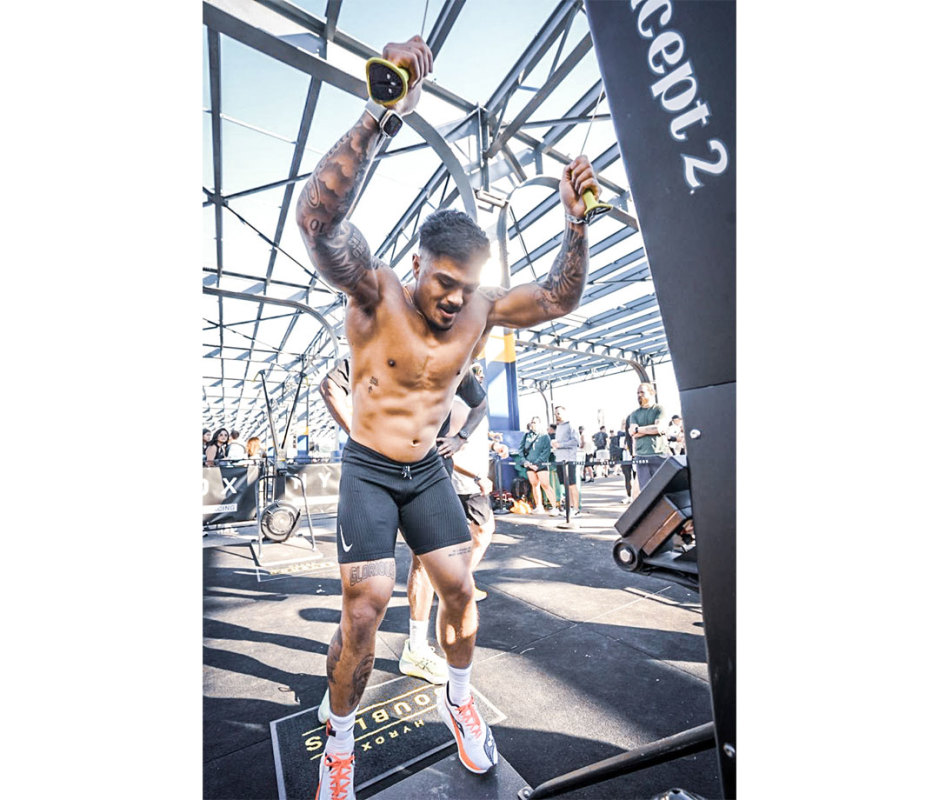Curious about the global fitness race that's exploded in popularity? The Hyrox workout has been incorporated into boutique and big box gym regimens and no doubt infiltrated your Instagram feed.
Hyrox is a smorgasbord of cardio and functional fitness that marries running with exercises like wall balls, sled pushes, and rowing. The event hosts competitions across rth America, Europe, Asia, and Oceania, with the 2024 season including over 60 races in 11 countries and 30 cities, often selling out in popular locales in a matter of minutes.
We're giving you the low down on the Hyrox workout: where it started, what it entails, and, most importantly, how to maximize your training.
What Is Hyrox?
Hyrox started in Germany in 2017 by Christian Toetzke, a longtime organizer of endurance events like triathlons, marathons and cycling races, and Moritz Furste, a German field hockey player and three-time Olympic medalist.
In the 2022/2023 season, over 90,000 athletes competed. A single event can include as many as 8,000 participants and 10,000 spectators, which is why the company calls itself the “world’s largest mass participation fitness race.”
While Hyrox hosts a highly competitive World Championships, the company says it “welcomes every participant with open arms.” To help alleviate concerns about being the last person to cross the finish line, a new wave of athletes starts every 10 minutes throughout the entire race day. According to the company, over 98 percent of athletes complete the race.
Additionally, the competition offers four divisions:
- Open, best for individuals who are just starting out
- Pro, for experienced racers
- Doubles, where you and a partner partition the workout stations
- Relay, where the work is split among four people.
What Is the Hyrox Workout?
Unlike a CrossFit competition, where the workouts are typically new and sometimes remain unknown until just before the athletes step on the floor, the format of a Hyrox workout is always the same: eight rounds of a 1-kilometer run followed by a station.
The exercises are always the same:
- SkiErg
- Sled push
- Sled pull
- Burpee broad jumps
- Rowing
- Farmer's carry
- Sandbag lunges
- Wall balls
The average time for a Hyrox workout is around 80 to 90 minutes, and the benefits are that it tests your strength, power, core stability, stamina, and coordination, says James Kelly, Hyrox coach and winner of the most recent Australian Hyrox race. However, what’s most importance is your endurance: “By far the biggest thing I’ve learned is that this is a running race before anything else.”
In addition to increasing your VO2 max, you'll want to prioritize glute exercises, leg exercises, abs exercises, back exercises, and arm exercises.
Here's how to do each movement in the Hyrox workout—plus a snapshot of the reps, distance, and weight by group.
| Women | Women Pro | Men | Men Pro | |
|---|---|---|---|---|
|
SkiErg |
1,000m |
1,000m |
1,000m |
1,000m |
|
Sled Push |
4 x 12.5m at 75kg (plus sled) |
4 x 12.5m at 125kg (plus sled) |
4 x 12.5m at 125kg (plus sled) |
4 x 12.5m at 175kg (plus sled) |
|
Sled Pull |
4 x 12.5m at 50kg (plus sled) |
4 x 12.5m at 75kg (plus sled) |
4 x 12.5m at 75kg (plus sled) |
4 x 12.5m at 125kg (plus sled) |
|
Burpee Broad Jump |
80m |
80m |
80m |
80m |
|
Rowing |
1,000m |
1,000m |
1,000m |
1,000m |
|
Farmer's Carry x 200m |
2 x 16kg |
2 x 24kg |
2 x 24kg |
2 x 32kg |
|
Lunges |
100m at 10kg |
100m at 20kg |
100m at 20kg |
100m at 30kg |
|
Wall Balls |
75 x 4kg |
100 x 6kg |
100 x 6kg |
100 x 9kg |
SkiErg
The movement mimics squatting and pulling mechanics, recruiting every part of your body for maximum efficiency.
Courtesy Image
How to Do It
- Grip the handles with a slight bend in your elbows and stand about an arm's length away from the machine, to start.
- Rise to the balls of your feet, reach arms up, then pull down hard, sending hips back and fists toward the ground, dropping into a slight crouch.
- Immediately push through heels to reverse, then pull again.
- Your upper body supplies the force for the first part of the pull, then your lower body (glutes especially) power the tail end.
Pro Tip
Resist the urge to go all-out. Remember, this is the first station and burning out too soon spells disaster for the rest of the race. The SkiErg has a flywheel with a lever to control resistance and a digital display to track splits. For sprint training, keep the tension at 5 to 8, and use distance traveled for each interval to ensure consistency throughout reps. If you’re training for endurance, bump it down to a 4 or 5 and set a distance to cover. The damper in competition is set to the following resistance, according to division:
- Women: 5
- Women Pro/Men: 6
- Men Pro: 7
You can adjust the damper to whatever resistance you like, just note you're not allowed to change it once you start.
Sled Push
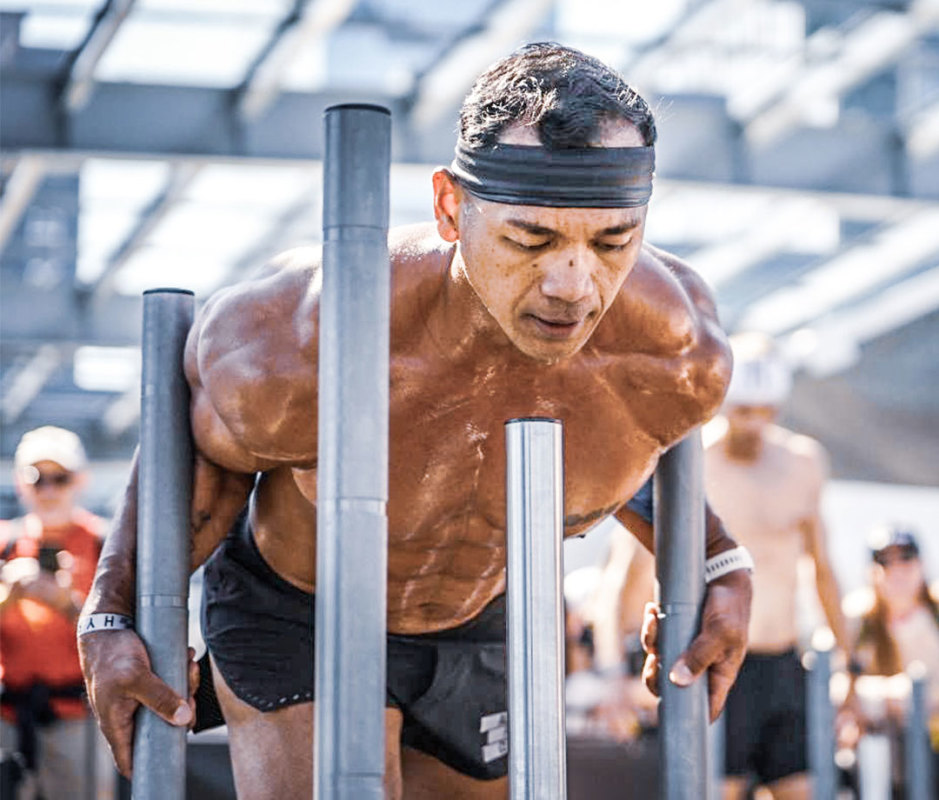
Hugging your arms around the sled's bars takes the strain off your shoulders.
Courtesy Image
How to Do It
- Set the sled with the weight you'll be using in competition, to start.
- Determine which stance you'll use or play with a combination: arms straight out with hands on high poles, hands on high poles with elbows tucked in, arms wrapped around the high poles, or arms wrapped down the poles.
- Hinge hips forward slightly and lean into the sled with your back straight and core engaged.
- Drive through the balls of your feet and push the sled with small, quick steps.
- You must stay within the designated lines of the Athlete's Box and push the sled over the line on each rep.
- Penalty: If you complete less than four reps (lanes), you'll get a penalty of 3 minutes per missing lane.
te: In competition, you must cover 50m and Hyrox sleds weigh approximately 30 kg so overall weight is as follows:
- Women: 102kg
- Women Pro: 152kg
- Men: 152kg incl. sled
- Men Pro: 202kg incl. sled
- Mixed Doubles: 152kg incl. sled
- Women Doubles: 102kg incl. sled
Pro Tip
Taller participants might find the close-grip stance easier to gain momentum (arms bent, elbows tucked, hands on high bars), while shorter athletes might find arms extended better as they're at a level height with the bars. If you're too high over the sled and push down, you'll cause it to tip and dig into the turf. Think about keeping a proud chest as you push the sled and stay as low and level as you can.
Sled Pull
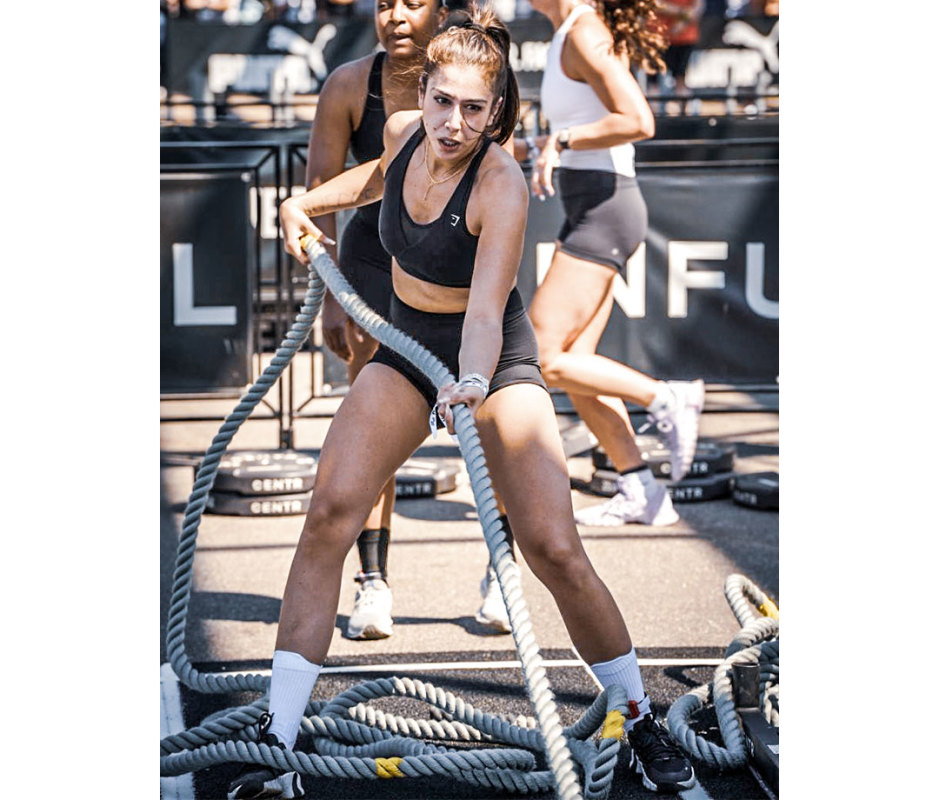
Pulling the rope to one side of your body keeps it from bunching at your feet.
Courtesy Image
How to Do It
- Assume an athletic stance, feet just wider than shoulder-width apart, to start.
- One technique will spare your legs and put the emphasis on your upper body: Grasp the rope with both hands and engage your lats to pull the rope toward one side of your body (shown), alternating which hand reaches forward, letting the rope coil behind you and to the side.
- The second technique engages the lower body to even the strain: Come into a quarter-squat position, then drive through your legs and extend through your hips as you simultaneously pull the rope toward you with both hands to gain more momentum.
- You must pull from a standing position at all times (no kneeling) and must stay within the designated lines of the Athlete's Box.
- Penalty: Taking any steps forward between repetitions is not allowed. If you violate any of these rules, the rep is void and needs to be repeated; moreover, a second warning warrants a 5m penalty.
Pro Tip
Don't let the rope pool and coil at your feet. You increase your odds of tripping over it.
Burpee Broad Jumps
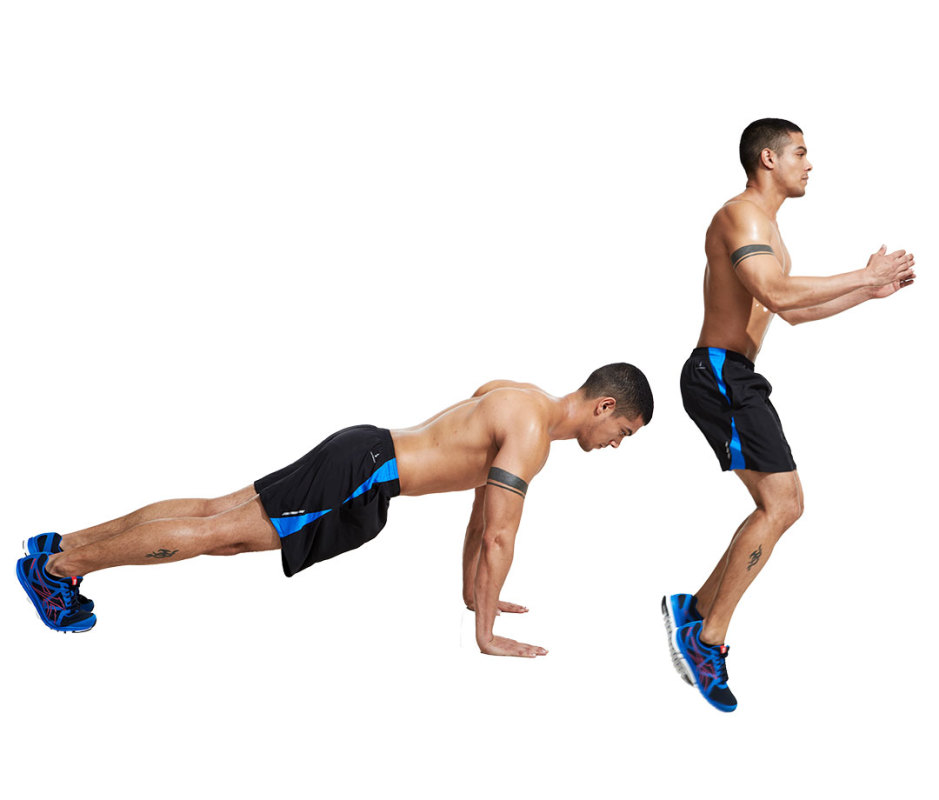
Step your feet together, rather than jumping to save energy.
Beth Bischoff
How to Do It
- From a standing position, bend down and touch your hands to the ground, behind the designated line, to start. Your hands can only be one foot-length away to meet Hyrox rules and once on the ground, they can't move forward.
- Drop your chest to the ground (it must touch) and shoot your legs out behind you so you're in the bottom position of a pushup.
- Step or jump your feet to stand, then jump forward, landing with both feet simultaneously.
- Penalty: Taking any steps forward between the repetitions is not allowed. If you violate any of these rules, the rep is void and needs to be repeated; moreover, a second warning warrants a 5m penalty.
Pro Tip
Step your feet together to stand, then jump forward to preserve energy. If you want to jump throughout the duration of the station, stay low and keep your body tipped forward to jump like a frog and maintain momentum.
Rowing

Remember rowing is largely a lower body movement, so power it with your posterior chain, not your upper body.
Courtesy Image
How to Do It
- Adjust the foot stretcher according to your shoe size so the straps are aligned with your midfoot, to start.
- Hold the handle at both ends, starting at the catch, where the handle is closest to the monitor. Angle your body forward so your shoulders are in front of your hips and arms are straight in front of you.
- Initiate the drive with your legs (think of a power clean). When your legs are almost straight, swing your body open while still keeping your arms straight.
- When your body is just past perpendicular, pull your arms into your body to finish the stroke (handle should be near sternum).
- Let your arms and body reset before you start the slide and bend your knees.
The damper in competition is set to the following resistance, according to division:
- Women: 5
- Women Pro/Men: 6
- Men Pro: 7
You can adjust the damper to whatever resistance you like, just note you're not allowed to change it once you start.
Pro Tip
A common mistake is relying on the upper body and arms to power the movement. Rowing is more about the connection between your hips and core. Maintain a steady pace so you don't burn out.
Farmers' Carry
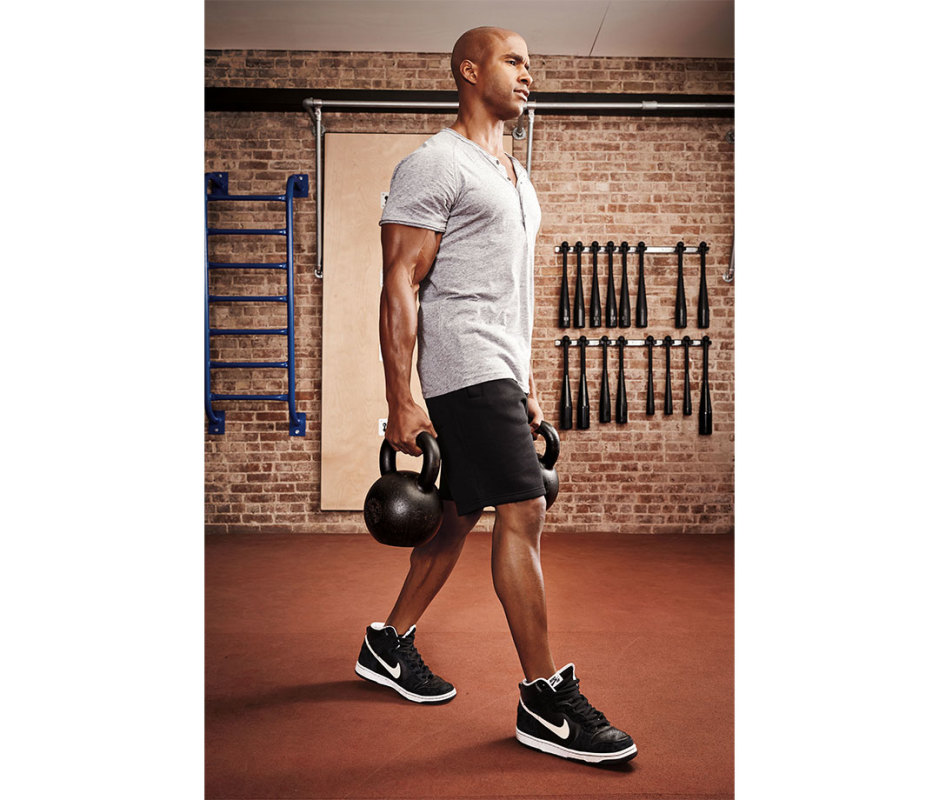
Grab the kettlebell horn at the front to tilt the bells back and ease the strain on your grip strength.
James Michelfelder
How to Do It
- Stand tall with a kettlebell in each hand, to start.
- Maintain a tall chest, retract shoulder blades, and keep weights from resting on thighs.
- Walk forward, using choppy, heel-to-toe steps.
- Ensure that your head is facing forward and your posture is rigid. You may rest the kettlebells on the ground if you need to reset.
Pro Tip
The Centr x HYROX Octo Kettlebell designed for competition has a flattened, eight-sided design for even weight distribution and to better carry the bells by your sides; they stay flush rather than bouncing around. Hold the horns at the front of the bell rather than the center so they tip back. This will lessen the strain on your grip strength, as the weights naturally hang back so you don't need to hold them so tightly. Try to move quickly through this station to minimize time under tension.
Sandbag Lunges
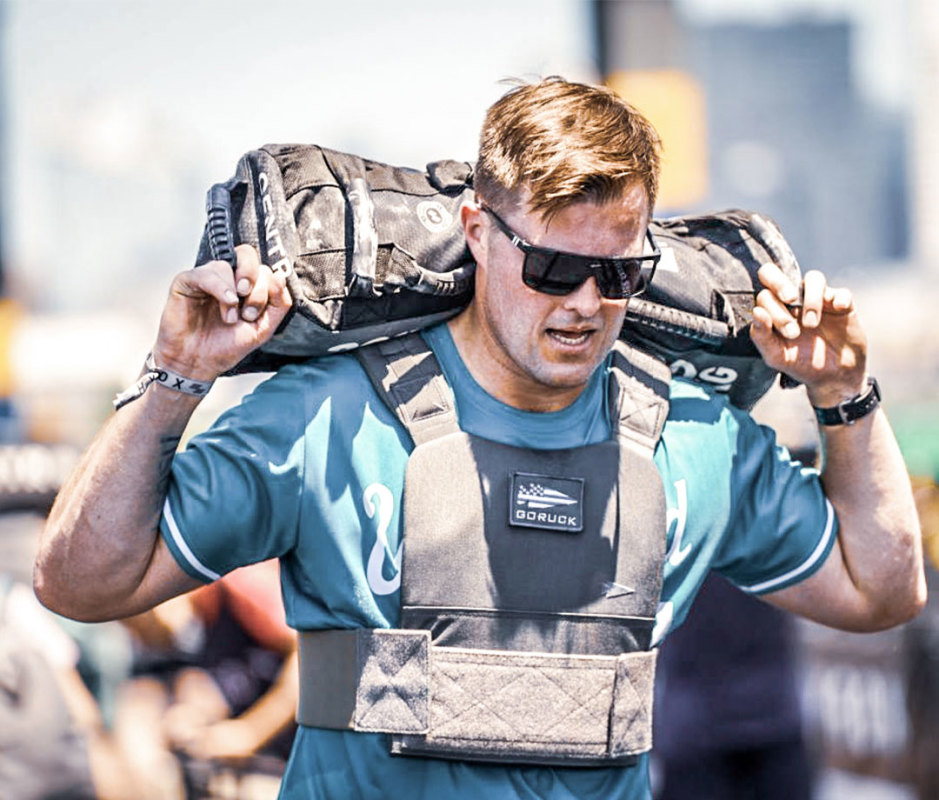
Don't let the sandbag touch the ground, whether competing solo or with a partner.
Courtesy Image
How to Do It
- Start with feet hip-width apart and the sandbag in front of you, to start.
- Grab the handles and clean the bag to your chest, press it overhead, then rest it on your shoulders behind your neck.
- Keeping your torso upright, lunge forward with left foot until right knee grazes the floor.
- Press through left foot to stand; then lunge forward with your right foot until left knee kisses the ground. Continue alternating on each rep.
- Penalty: You must not take any steps in between lunges, nor can you drop the sandbag. If you're competing with a partner, you must transfer the sandbag back-to-back without lowering it. Failure to do so with incur a 5m penalty. If competing in Doubles, the non-working partner walks behind the working partner, however if they obstruct other participants, a 10m penalty is issued.
Wall Balls
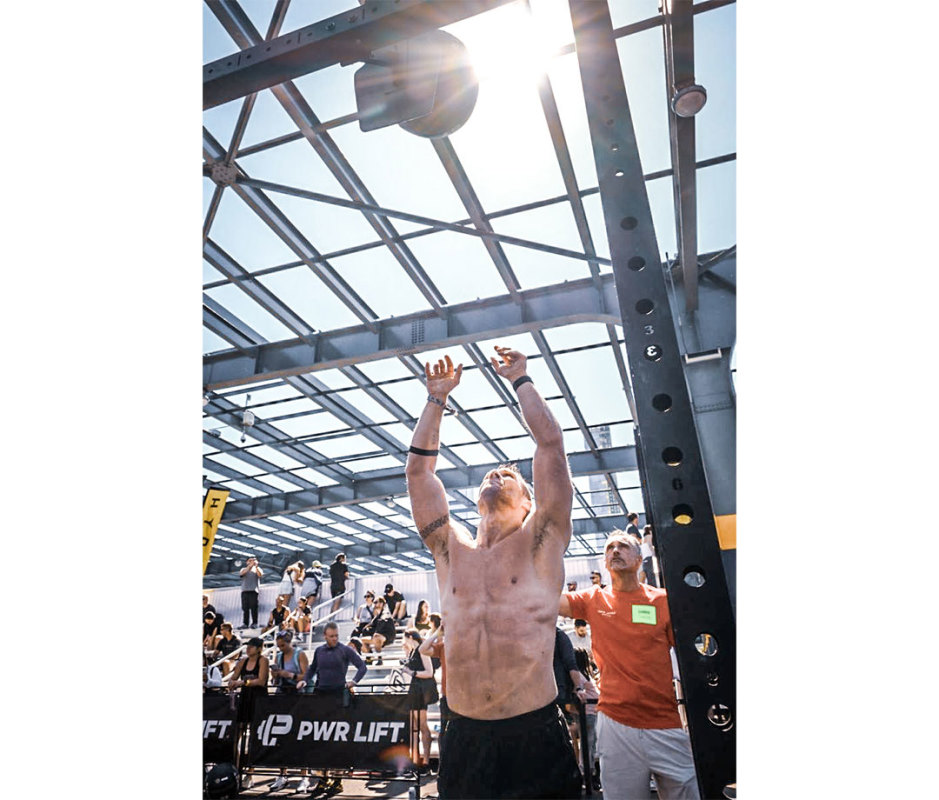
A box or bucket may be used to ensure athletes lower more than 90 degrees at the bottom of the squat.
Courtesy Image
How to Do It
- Stand facing a sturdy wall or wall ball target, with feet slightly wider than shoulder-width apart, elbows bent at rib cage, ball under chin, to start.
- Drop hips into a low squat (hips must descend below 90 degrees), then drive up with legs, extending arms overhead to toss the medicine ball to the target.
- Women must hit the 9-foot target in the center and men must hit the 10-foot target in the center.
- Catch and use the ball’s momentum to return to a squat and repeat.
Pro Tip
Make a strategy. Since this is the last event, you'll likely need to break the reps into sets to shake your arms out and take a breather in between.
Expert Tips for Hyrox Workouts
1. Treat Running Like a Skill
Because running is so fundamental to the Hyrox workout, Kelly recommends first-timers treat it as a skill they need to work on.
“You have to look at your running technique, volume, and training program,” he says. The key, he adds, is to get enough volume under your legs by doing this: Estimate how long the entire race will take, including the 8km (nearly 5 miles) of running and the eight workout stations. If that’s 90 minutes, you should work up to being able to run for 90 minutes straight. “Take it nice and slow,” he says, "no intensity whatsoever.”
Along those lines, Kelly says the biggest mistake he sees is people focusing too much on speed.
“They think the way to get faster is to go as hard as possible in their workouts," he says, which is counterintuitive. "If you try to run 400 meters as fast as possible, your technique will break down, and you’re teaching yourself to run poorly.”
2. Train the Sled Pull and Push in Isolation
As for the workout stations, in Kelly’s experience as a coach and an athlete, the two most difficult movements are the sled pull and push. He recommends training these movements in isolation. Then, about a month out from the race, you can incorporate them into a larger workout with running and the other stations. “It blends in all together all by itself,” he says.
3. Practice Pacing
On race day, pacing is everything. Because the Hyrox workout will likely be at least an hour of non-stop movement, “there’s no point in going out too hot,” Kelly says. And because running is so essential, he suggests you pull back on a station so you can jump straight into the run when you finish. As you get more experience, you’ll naturally start to understand where you can push the tempo and where to hold back.
4. Get the Right Equipment
To simulate a Hyrox workout, you don’t necessarily need a specialized gym, but it’s best to have certain equipment that’s difficult to replicate, like the SkiErg and the rowing machine. If you don’t have a sled to push, Kelly points out that this is a unilateral movement (e.g. one leg a time), so you can sub in any comparable exercise, like heavy walking lunges, heavy box stepups, or heavy Bulgarian split squats. Similarly, for the sled pull, you just need to work your posterior chain through deadlifts (or deficit deadlifts), rope pulls, lat pulldowns, and bentover rows.
5. Practice the Race
Apart from that accessory work, and focusing on each of the stations in isolation, Kelly says the best way to prepare is to do some version of the race—especially if you’re just beginning your Hyrox workout journey. You don’t need to go full-send beforehand, but try these routines to familiarize yourself with the Hyrox workout.
Simulation Hyrox Workout #1: The Half-Race
- 500-meter run
- 500-meter SkiErg
- 500-meter run
- 25-meter sled push (152kg for men, 102kg for women)
- 500-meter run
- 25-meter sled pull (103kg for men, 78kg for women)
- 500-meter run
- 40-meter burpee broad jump
- 500-meter run
- 500-meter row
- 500-meter run
- 100-meter farmers carry (2 x 24 kg for men, 2 x 16kg for women)
- 500-meter run
- 50-meter sandbag lunges (20kg for men, 10kg for women)
- 500-meter run
- 50 wall balls (6kg for men, 4kg for women)
Simulation #2: The Two-a-Day
In the morning:
- 1-kilometer run
- 1-kilometer SkiErg
- 1-kilometer run
- 50-meter sled push (152kg for men, 102kg for women)
- 1-kilometer run
- 50-meter sled pull (103kg for men, 78kg for women)
- 1-kilometer run
- 80-meter burpee broad jump
In the afternoon:
- 1-kilometer run
- 1-kilomter row
- 1-kilometer run
- 200-meter farmers carry
- 1-kilometer run
- 100-meter sandbag carry (20kg for men, 10kg for women)
- 1-kilometer run
- 100 wall balls (6kg for men, 4kg for women)
Simulation #3: The Partner Workout
You and your partner must complete all the running together, but you can partition the work stations however you like.
- 1-kilometer run
- 1-kilometer SkiErg
- 1-kilometer run
- 50-meter sled push (152kg for men, 102kg for women)
- 1-kilometer run
- 50-meter sled pull (103kg for men, 78kg for women)
- 1-kilometer run
- 80-meter burpee broad jump
- 1-kilometer run
- 1-kilometer row
- 1-kilometer run
- 200-meter farmers carry
- 1-kilometer run
- 100-meter sandbag carry (20kg for men, 10kg for women)
- 1-kilometer run
- 100 wall balls (6kg for men, 4kg for women)

